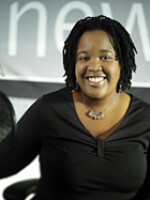ED GORDON, host:
I'm Ed Gordon, and this is NEWS & NOTES.
Today is America's 229th birthday. It's also the 100th birthday of California's famous Venice Beach. Behind the scenes, an African-American designer, Arthur Reese, helped shape Venice's character. His granddaughter tells our correspondent Farai Chideya his story and her own.
Ms. SONIA REESE-DAVIS(ph) (Granddaughter of Arthur Reese): My name is Sonia Reese-Davis, and we're standing at the corner of Pacific Avenue and Windward Avenue, which was the entrance to the Venice Pier ...(unintelligible). Venice Beach opened in 1905. My grandfather came in 1903. Then as Venice built, Abbot Kinney's dream was to have it like a Coney Island by the sea.
FARAI CHIDEYA reporting:
And Abbot Kinney was the man who really sat down a stake as a businessman to create this fantasy world of canals and lagoons in Venice Beach. What was your grandfather's relationship to Abbot Kinney, or how did he meet him?
Ms. REESE-DAVIS: He was hired by the Abbot Kinney Company in the janitorial department, and he soon rose to the head of janitorial department. But one day Mr. Kinney, soon after they opened, bought some decorations. What Mr. Reese did, he innovated decorating every pillar, every rafter, you know, so that it made a whole fantasy environment. The decorations was one of the things that made the fantasy land a real success. I think in their own ways, they were both visionaries, Mr. Kinney and Mr. Reese. I think their relationship became close. Mr. Kinney always called Mr. Reese `Mr. Reese,' and...
CHIDEYA: That was unusual for a white man to call a black man by an honorific.
Ms. REESE-DAVIS: Exactly. You know, people of color could not partake of many of the amusements on the pier.
CHIDEYA: Let me just describe where we are, and you tell me a little bit more about what used to be here. We are, as you mentioned, at the corner of Pacific and Windward Avenue in Venice Beach. As you sort of look around in a panorama, you have a bank, a cafe, a youth hostel. It's very bohemian and colorful, with murals on the walls. What do you think it looked like in your grandfather's time?
Ms. REESE-DAVIS: The building at the corner with the mural on it has pillars. These are...
CHIDEYA: There are faces paint--sculpted into the pillars.
Ms. REESE-DAVIS: Right, and the faces alternate. They're, you know, not all the same face. Very ornate. And these ornate pillars went the length, two or three blocks, down to the ...(unintelligible) on both sides of the street. It was really beautiful and it was great for decorating. This was all walking area, no wheels unless they were bicycles, and people would have their umbrellas and their large dresses; men had their suits. And it would just fill Windward Avenue with crowds of people. You couldn't even see the street.
He and Kinney became close businessmen. In 1910, Mr. Reese went to Mr. Kinney and said, `To bring our people back to the Venice Pier,' because there were other piers in competition, `let's have a Mardi Gras.' So they instilled a Mardi Gras in August.
CHIDEYA: Let's take a little walk back towards what is now a post office. We're walking on one of Venice's wide boulevards. It's loud, no bones about it.
Ms. REESE-DAVIS: We're standing in front of the post office, and there's a circle in front of it, and all the streets going off from the circle like a star were canals.
CHIDEYA: And there were actual gondolas that would go down these canals, correct?
Ms. REESE-DAVIS: Correct. My grandfather could not--found it hard to keep employees in his janitorial service. So he encouraged--because they all had to come from Los Angeles; nobody could live here. They came...
CHIDEYA: There was a restrictive covenant on who could buy homes?
Ms. REESE-DAVIS: Exactly. So little by little, there was, you know, a Jewish person here and there who would sell a lot to one of us, sold a lot to my grandfather. He built a house. He encouraged his cousins to come and build a little shack in the back of his house, and they did. But in succession, they would live in this little shack and they would go on and institute their own business. Each one in succession would build houses on the back of their houses and bring more relatives. So they kind of started the black community that way.
CHIDEYA: Venice is celebrating, literally on July 4th, its centennial, a hundred years of this community, of Venice Beach, so before we let you go, tell us a little bit about some of the centennial celebrations that have been going on.
Ms. REESE-DAVIS: The events will go on through the entire year. There was a carnival and there was the Venice parade. And one thing about Venice, it's very unpredictable. So you read in the newspaper of all these things that are going to happen. They not only happen, but 50 more things happen.
CHIDEYA: So if your grandfather were alive today, if Mr. Reese were alive today, what do you think he would do to celebrate the centennial?
Ms. REESE-DAVIS: Oh, I think he would decorate.
CHIDEYA: Thank you so much, Sonia, for showing me a bit about Venice and your grandfather's history.
Ms. REESE-DAVIS: Well, thank you. I'm honored.
CHIDEYA: Farai Chideya, NPR News. Transcript provided by NPR, Copyright NPR.


